AT OUR TABLE
- AUTUMN CLASS SCHEDULE
|
We have a great line-up of cooking classes
that will expand your culinary horizons. Call The Prairie Table at 319-337-3325 for
additional information and to reserve a class space.
Thursday, October 18th -
Cheesecakes - Amy Moore, Pastry Chef, and Owner of Olive and
James Bakery. Chef Amy will prepare a Goat Cheese Cheesecake
with Lemon Curd, White Chocolate Cheesecake, and a Savory Sun-dried
Tomato, Leek, and Mozzarella Cheesecake. $24.99
Tuesday, October 23rd - Oyster and Clams
on the Half Shell - James Braddy, Fortune Fish Company.
Come taste several different Oysters and Clams on the half-shell
with different sauces. You will also learn how to open these
"unbreakable" bivalves. $29.99
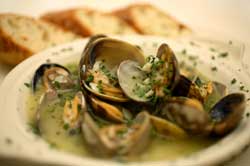 Tuesday, October 30th - World Chocolate
Tasting - David Nicholson, Cheese and Chocolate Expert.
Discover the amazing flavors of chocolates from around the world.
You will learn the flavor profiles, and differences of single
plantation chocolate. $24.99 Tuesday, October 30th - World Chocolate
Tasting - David Nicholson, Cheese and Chocolate Expert.
Discover the amazing flavors of chocolates from around the world.
You will learn the flavor profiles, and differences of single
plantation chocolate. $24.99
Thursday, November 8th - Middle Eastern
Holiday Recipes - Marwa Ibrahim. Marwa will teach you
how to prepare regional Holiday favorites like the popular dessert
Baklava, savory Egyptian rice made with caramelized sugar and nuts,
a delicious Lebanese wrap of beefsteak and a special tahini sauce,
and she will explain how to prepare Arabic pot roast.
$24.99.
Tuesday, November
13th - A Twist on Thanksgiving Table - Katherine
Habley. Surprise your family and friends this Thanksgiving
with a Creamy Pumpkin Cheesecake, Cranberry Fruit Conserve, Sweet
Potatoes Supreme, and delicious Pumpkin Soup.
Wednesday, November 14th - Rhone Wines for
Your Thanksgiving Table - Morgan Weiss, Sommelier, Prairie
Table. Taste wines that will enhance all the fabulous flavors
coming from your Thanksgiving table. These fruity, flavorful
wines will surely be a hit.
Thursday, November 15th - Fabulous Fresh
Pasta and Sauces - Willy Blackmore. Willy will prepare
a classic Butternut Squash Ravioli with Sage and Brown Butter Sauce,
Minted Pea and Ricotta Ravioli, Linguini and Clams with Caramelized
Onion and Roasted Tomato, Paperdelle with Arugala, Radicchio, and
Lemon, and Nannie-style red sauce with Pepperoni. This is a
hands-on class, and limited to 12 people, so hurry and sign up while
space is available.
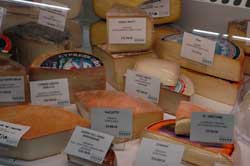 Tuesday, November 27th - Cheese and Wine
Pairing - Stephanie Caraway, Certified Sommelier, and Robert
Fromm, Chef, Prairie Table. We are doing another wine and
cheese pairing, and this one is more for the holiday season. We will
be tasting specialty cheeses and wines brought in just for the
holidays! $29.99 Tuesday, November 27th - Cheese and Wine
Pairing - Stephanie Caraway, Certified Sommelier, and Robert
Fromm, Chef, Prairie Table. We are doing another wine and
cheese pairing, and this one is more for the holiday season. We will
be tasting specialty cheeses and wines brought in just for the
holidays! $29.99
Wednesday,
November 28th - Alsatian WInes - Morgan Weiss, Sommelier,
Prairie Table. Come and experience delicious white wines that
taste like winter.
Tuesday,
December 4th - Christmas Candy - Katherine Habley.
Katherine will prepare English Toffee, Peanut Butter Fudge, Candied
Orange Peel Dipped in Dark Chocolate, and delicious Soft, Creamy
Caramels. She will also give you the recipe for one of her
favorite Christmas goodies, Coconut Kisses.
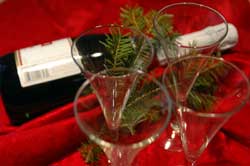 Wednesday, December 5th - Ports -
Morgan Weiss, Sommelier, Prairie Table. Come and taste these
delicious sweet fortified wines that will keep you warm this
winter. Wednesday, December 5th - Ports -
Morgan Weiss, Sommelier, Prairie Table. Come and taste these
delicious sweet fortified wines that will keep you warm this
winter.
Wednesday, December
19th - Champagne and Champagne Style WInes from Around the
World - Morgan Weiss, Sommelier, Prairie Table. Come
and enjoy one of my favorite things in the world-Bubbly. We
will be tasting a variety of sparklings from around the world, just
in time for the Holiday's. So, come clink your glasses with us
at our last class for the year. Cheers!
Call The
Prairie Table at 319-337-3325 for information and to reserve a class
space. |
SOUPS
and STEWS
|
|
Soups and stews are
simple to prepare and the fabulous homemade results far surpass any
red-and-white canned imitations. A great pot of
soup is a perfect one-dish meal. Perhaps the best
part of homemade soup are the leftovers; what a relief to find a
healthy lunch or supper ready to go the next day or later in the
week. There are many categories of soups that by
their definition help us to identify their preparation method:
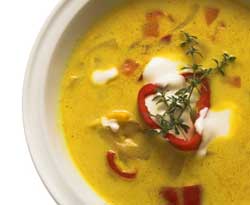
Soup - any number of
combinations of vegetables, fruits, meats or fish cooked in a
liquid; a broad term covering a lot of culinary ground.
Stew - vegetables and meat
in a broth thickened by the natural juices and the partial breakdown
of its components; distinguished from soup by its natural
thickness.
Bisque - a thick, pureed soup
with cream; originally a term used only for seafood preparations, it
now describes poultry or vegetable-based fare as well.
Consommé
- a
broth prepared from a meat or fish base, strained and
clarified.
Chowder - a thick, chunky soup;
a term originally reserved for seafood preparations, chowder is now
often used for any chunky soup.
Potage - a pureed soup
thickened with cream and egg yolks; French in origin.
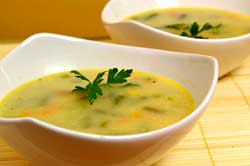 Mulligan
Stew -
a thick stew made with whatever meat, potatoes, and vegetables at
hand. Mulligan
Stew -
a thick stew made with whatever meat, potatoes, and vegetables at
hand.
Posole - a thick, hearty soup
of Mexican origins made with pork or chicken, hominy, onion, garlic,
dried chiles and cilantro. Often topped with
fresh chopped vegetables such as lettuce, radishes, onions, or with
cheese.
Cioppino - a spicy Italian stew
made with tomatoes and a variety of fish and shellfish.
Bouillabaisse - a seafood stew with
fish, shellfish, onions, tomatoes, white wine, garlic, saffron and
other herbs; French in origin.
Burgoo - traditionally made
with game, now any combination of meats and vegetables ranging from
potatoes, onions, cabbage, carrots, sweet green peppers, corn, okra,
lima beans and celery; the term is originates from Kentucky.
Some soup titles belong
to a single, specific dish all to themselves:
borscht, callaloo, gazpacho, vichyssoise, or any number of
wonderful liquid-based dishes.
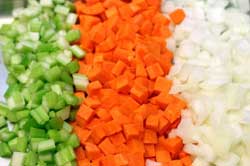 Starting the
Soup --
It's hard to envision a hearty soup without starting with an
onion. Two parts onion, one part celery, and one
part carrot all in a small dice and you have the classic
mirepoix, or the "aromatics" for the flavor base of many
soups, stocks, and stews. A quick sauté of the
mirepoix and any dried spices that need blooming, and the
soup is started. Starting the
Soup --
It's hard to envision a hearty soup without starting with an
onion. Two parts onion, one part celery, and one
part carrot all in a small dice and you have the classic
mirepoix, or the "aromatics" for the flavor base of many
soups, stocks, and stews. A quick sauté of the
mirepoix and any dried spices that need blooming, and the
soup is started.
Stock - the liquid component
to soups and stews, (water, prepared stock, or homemade stock) will
define the flavor outcome. Prepared stocks offer
quick access to this essential ingredient. Choose
a low sodium variety for soup making as the liquid concentrates
during preparation. Homemade stocks are easier to
make than you might think. America's Test Kitchen
has trialed umpteen methods for homemade chicken and beef stocks in
their latest cookbook, The New Best Recipe.
They note that the secret to great beef stock is good
browning of the meat prior to adding any liquid.
The fond, (brown bits), contain a huge amount of flavor that
are necessary for a good-tasting beef stock.
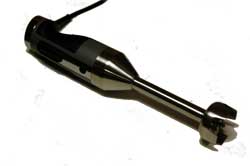 Ingredients - Additions to the
flavor base and liquid component include all possible meat, fowl,
vegetables and fruit choices. Not too many rules
at this stage! In general though, do make pieces
spoon-size. Add ingredients according to their
cooking times. For example, add root vegetables
early, leafy greens at the last and fresh herbs at the very end. Ingredients - Additions to the
flavor base and liquid component include all possible meat, fowl,
vegetables and fruit choices. Not too many rules
at this stage! In general though, do make pieces
spoon-size. Add ingredients according to their
cooking times. For example, add root vegetables
early, leafy greens at the last and fresh herbs at the very end.
Finishing
-
Before serving adjust the seasonings. Add any
milk or cream at the end of soup preparation.
Allow the soup to reheat, but not boil, after the addition of
the milk or cream. Many fine soups will have a
finishing step of pureeing. A blender will
produce the most consistent puree, but a food processor will also
suffice. An immersion blender is our favorite for
this task because it avoids (1) the transfer of hot liquid, (2) the
dilemma associated with processing multiple batches, and (3) the
extra clean-up.
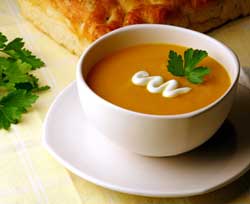 Presentation - Soup's pleasure lies
not only in its taste and filling character, but also in the steamy
aromas that lead us to the bowls waiting to warm our
hands. Choose bowls intended for
soup. Shallow bowls, sometimes known as soup
plates, allow soup to cool quickly and are appropriate for the
smaller quantities of a first course. Deep,
thick-walled bowls are well-suited for entrée soups.
Consider garnishing your soup, especially pureed soups, with
a dollop of sour cream, chopped fresh herbs, or crunchy
croutons. Soup tureens and ladles add a necessary
level of elegance when serving soup at the table or on a
buffet. Presentation - Soup's pleasure lies
not only in its taste and filling character, but also in the steamy
aromas that lead us to the bowls waiting to warm our
hands. Choose bowls intended for
soup. Shallow bowls, sometimes known as soup
plates, allow soup to cool quickly and are appropriate for the
smaller quantities of a first course. Deep,
thick-walled bowls are well-suited for entrée soups.
Consider garnishing your soup, especially pureed soups, with
a dollop of sour cream, chopped fresh herbs, or crunchy
croutons. Soup tureens and ladles add a necessary
level of elegance when serving soup at the table or on a
buffet.
|
THE SOUP POT
|
|
A good soup pot not only
makes a great soup, it becomes a modern icon imbued with all the
connotations of hearth and home in the contemporary kitchen. We know
of some soup pots that are designated heirlooms!
A good soup pot is large, but not so large to
challenge handling of the pot; we think a 5-8 quart size is good for
the home kitchen. A thick-walled pot is important to distribute heat
evenly and prevent scorching at the heat source.
A well-fitting lid will keep liquids from escaping too
rapidly. Two handles that provide a solid grip,
even with potholders, are a must for moving a full pot. The choices
for a good soup pot fall into some basic categories:
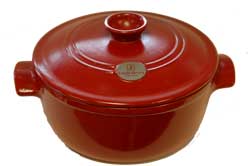 Ceramic and Clay
Pots -
Clay pots, also known as ceramic (fired clay), have a natural
insulating character that retains heat very well.
This insulating capability increases cooking times slightly
while the pot initialing warms up. Clay-based
pots have a sturdy glaze that seals the clay, provides a nearly
non-stick surface, and bestows wonderful color in the kitchen and on
the table. Most ceramic cooking pots are safe for
the oven, dishwasher, freezer, and microwave.
Check to see if your pot is safe for the direct heat of a
gas, electric, or halogen stovetop. We recommend
Emile Henry's "Flame" series for stovetop
cooking. Originating in the Burgundy region of
France, Emile Henry cookware is known for its rich colors,
scratch-resistant glaze, and for developing the first ceramic
cookware to be used with direct heat. Ceramic and Clay
Pots -
Clay pots, also known as ceramic (fired clay), have a natural
insulating character that retains heat very well.
This insulating capability increases cooking times slightly
while the pot initialing warms up. Clay-based
pots have a sturdy glaze that seals the clay, provides a nearly
non-stick surface, and bestows wonderful color in the kitchen and on
the table. Most ceramic cooking pots are safe for
the oven, dishwasher, freezer, and microwave.
Check to see if your pot is safe for the direct heat of a
gas, electric, or halogen stovetop. We recommend
Emile Henry's "Flame" series for stovetop
cooking. Originating in the Burgundy region of
France, Emile Henry cookware is known for its rich colors,
scratch-resistant glaze, and for developing the first ceramic
cookware to be used with direct heat.
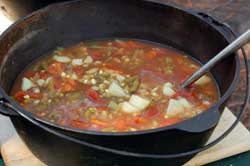 Cast Iron
Pots -
There's probably a cast-iron Dutch oven in your family's
past. These large pots served faithfully over
campfires and on wood stove, and have adapted to the stovetop
without needing any design makeover. Cast iron
pots have the requisite characteristics of thick bottoms and sturdy
walls for even, all-over heating. They have the
bonus of naturally contributing iron to our diets.
Like all cast iron cookware, a cast iron soup pot requires
appropriate care. A seasoned cast iron pot is one
that has been sealed with oil which prevents the natural rusting
that occurs when iron is exposed to air and water. Cast Iron
Pots -
There's probably a cast-iron Dutch oven in your family's
past. These large pots served faithfully over
campfires and on wood stove, and have adapted to the stovetop
without needing any design makeover. Cast iron
pots have the requisite characteristics of thick bottoms and sturdy
walls for even, all-over heating. They have the
bonus of naturally contributing iron to our diets.
Like all cast iron cookware, a cast iron soup pot requires
appropriate care. A seasoned cast iron pot is one
that has been sealed with oil which prevents the natural rusting
that occurs when iron is exposed to air and water.
To season a pan for the
first time, rub all surfaces with oil. Remove any
excess oil and place in a 300 degree oven for one hour.
Remove and wipe again, and the pot is ready.
Soap will break down the pot's seasoned quality, so only warm
water is recommended for cleaning. For stuck on
food, a scouring pad or coarse salt can be a helpful
abrasive. Some suggest boiling water in the pan
to remove stuck on food. Wipe dry cast iron pots
immediately after cleaning and occasionally wipe them with a lightly
oiled cloth before storing. Store with the pot
lid off to avoid any collection of moisture and rust development
inside the pot. Rusty cast iron pans can be
reconditioned with steel wool, then, re-seasoned with oil and heat
to reclaim its usefulness.
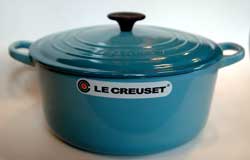 Enameled Cast Iron
Pots -
Building on the great qualities of cast iron cookware, enameled cast
iron pieces solve the potential dilemma of rusty pans.
The enamel coating covers all surfaces of the iron while
maintaining versatility on the stovetop and oven.
Besides the added functionality of an enameled surface, the
colors look great! Enameled cast iron is at its
best when cooking with medium to low heat. Use
wooden, heat-resistant plastic, or nylon utensils to preserve the
inner surfaces of the pot. For hard-to-clean
pots, soak in warm, soapy water; never use a scouring pad on
enameled surfaces. Baked on stains may be removed
by soaking the pan with a weak bleach solution (one teaspoon bleach
to every 2 cups of water) for a couple of hours and rinsing well. Enameled Cast Iron
Pots -
Building on the great qualities of cast iron cookware, enameled cast
iron pieces solve the potential dilemma of rusty pans.
The enamel coating covers all surfaces of the iron while
maintaining versatility on the stovetop and oven.
Besides the added functionality of an enameled surface, the
colors look great! Enameled cast iron is at its
best when cooking with medium to low heat. Use
wooden, heat-resistant plastic, or nylon utensils to preserve the
inner surfaces of the pot. For hard-to-clean
pots, soak in warm, soapy water; never use a scouring pad on
enameled surfaces. Baked on stains may be removed
by soaking the pan with a weak bleach solution (one teaspoon bleach
to every 2 cups of water) for a couple of hours and rinsing well.
We recommend Staub
and Le Creuset enameled cast iron cookware.
Le Creuset pots are formed from unique castings.
Each casting is destroyed after the pan is completed making
each piece a one-of-a-kind edition! We love the
bright, distinctive colors of Le Creuset! Our
staff is split on what color their favorite is - the Caribbean blue,
the spring green, or the classic deep red. But
you choose your favorite.
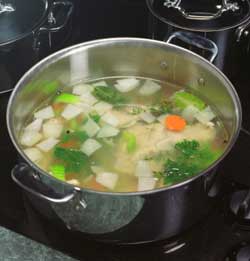 Stainless Steel
Pots -
These pots are also great choices for a durable soup
pot. Stainless steel pots layer stainless steel
on the inside and outside of an inner aluminum core.
Aluminum is an excellent conductor of heat across
the bottom of the pot and up the sides. Heat from
all sides produces evenly cooked food, (as opposed to scorched
bottoms and chilled tops). The stainless exterior
provides a highly durable surface and relative inertness when in
contact with food. The bonding of these metals
makes the "whole greater than the sum of its parts."
Sturdy metal handles make stainless steel pots easily mobile
from stovetop to oven. Stainless Steel
Pots -
These pots are also great choices for a durable soup
pot. Stainless steel pots layer stainless steel
on the inside and outside of an inner aluminum core.
Aluminum is an excellent conductor of heat across
the bottom of the pot and up the sides. Heat from
all sides produces evenly cooked food, (as opposed to scorched
bottoms and chilled tops). The stainless exterior
provides a highly durable surface and relative inertness when in
contact with food. The bonding of these metals
makes the "whole greater than the sum of its parts."
Sturdy metal handles make stainless steel pots easily mobile
from stovetop to oven.
We recommend
All-Clad Stainless Steel Pots. This brand has earned
its way to classic status through consistent performance in
professional and home kitchens.
|
SLOW and EASY
|
|
What barbequing is to
grilling, slow cookers are to the stovetop pot - a slow and
easy-does-it approach to applying cooking temperatures to
food. 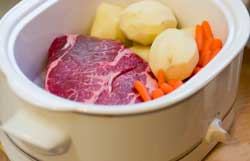 Slow-cookers apply low
temperature while retaining high moisture levels.
This slow-and-low method mixes flavors and turns tough meats
into tender morsels with very little preparation or
effort. Maintaining a low temperature
consistently without scorching required near constant monitoring for
our grandmothers. This changed in 1971 when Rival
introduced the Crock-Pot®, an instant hit with home cooks
everywhere. What a great feeling to come home
after a long day at work and be greeted by the aromas of a ready
meal. Over the years, the slow cooker has become
an even more valuable, effective, and energetically smart kitchen
appliance. A typical slow cooker uses the same
amount of energy as a 75 watt light bulb, much less than a stovetop
burner's consumption. Today's slow cookers easily
surpass early versions with additional features, while still
maintaining simplicity. When looking for a slow cooker, consider
the following features: Slow-cookers apply low
temperature while retaining high moisture levels.
This slow-and-low method mixes flavors and turns tough meats
into tender morsels with very little preparation or
effort. Maintaining a low temperature
consistently without scorching required near constant monitoring for
our grandmothers. This changed in 1971 when Rival
introduced the Crock-Pot®, an instant hit with home cooks
everywhere. What a great feeling to come home
after a long day at work and be greeted by the aromas of a ready
meal. Over the years, the slow cooker has become
an even more valuable, effective, and energetically smart kitchen
appliance. A typical slow cooker uses the same
amount of energy as a 75 watt light bulb, much less than a stovetop
burner's consumption. Today's slow cookers easily
surpass early versions with additional features, while still
maintaining simplicity. When looking for a slow cooker, consider
the following features:
(1)
Programmable timers allow
the machine to switch to a "warm" mode at the end of the cooking
cycle to prevent overcooking a meal; a handy feature for those of us
with irregular schedules.
(2)
Removable inserts allow
for easier cleaning and separation from the heating
element.
 (3)
Dual purpose inserts allow
browning of meat on the stovetop, then a pot transfer to the slow
cooker for the long, slow portion. (3)
Dual purpose inserts allow
browning of meat on the stovetop, then a pot transfer to the slow
cooker for the long, slow portion.
(4) Clear lids allow for
viewing of the cooking without lifting the lid - a no-no in slow
cooking.
(5)
An "On" light offers that
visual reassurance that the cooker is on and doing its
work.
(6)
Sturdy handles on the
insert make the transfer from stovetop to cooker, and then cooker to
sink, more secure and easily facilitated.
(7)
An oval shape accommodates
roasts or whole chickens more easily.
When preparing a meal
for the slow cooker, root vegetables tend to take longer to cook;
place these at the bottom of the cooker with the meat on
top. More delicate ingredients, like seafood, may
be added during the last hour of cooking. Dairy
products may be added in the last 15 minutes of cooking to maintain
integrity.
|
PLAN AHEAD TIPS
|
Tip #1: Slow
cooking is a "plan ahead tip" just by
definition. Keep the following
ingredients in the pantry for quick assembly:
dried beans, prepared
broths, tomato paste, tomato juice, potatoes, onions, and frozen
vegetables. 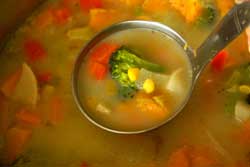 Wash and cut vegetables
and meats the night before; refrigerate, place in the slow cooker in
the morning for a ready supper that night. Wash and cut vegetables
and meats the night before; refrigerate, place in the slow cooker in
the morning for a ready supper that night.
Tip #2: If
you like to make your own stock, or if you always seem to have half
a can of stock leftover from a recipe, freeze it in a zippered
freezer bag and pull out when preparing your next soup.
Alternatively, freeze portions of stock in a silicone muffin
pan. Once frozen the stock "chunks" are easily
removed from the mold and may be bagged and used in quantities as
needed. |
Q &
A's
|
|

Q: I
forgot to thaw my roast for tonight's dinner. Can
I still put it in the slow cooker and just cook on high for a longer
time?
A: No.
While frozen food can be made in a slow cooker (i.e., freezer meals
made for slow cooker), it is not recommended to place large pieces
of frozen food like roasts or chickens in the slow
cooker. It is not guaranteed that the slow cooker
will be able to bring the meat up to a required temperature of at
least 140 degrees within 4 hours. Temperatures
below this encourage bacterial growth.
Q: I
have over salted my soup. Should I add more
liquid to dilute or is it ruined?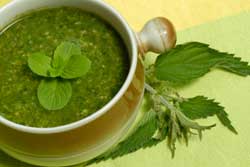
A:
Thinning the soup or adding additional ingredients is one way
to handle the situation. Another method is to add
a potato or two to the soup; they will absorb the salt and may be
discarded prior to serving. A light hand in
seasoning your soup or stew will allow the natural flavors of the
main ingredients to emerge and meld. As it cooks,
soup reduces in volume and the flavors tend to concentrate over
time.
Q: My
soup is too thin. What is the best way to thicken
it?
A: A
roux, a slurry of cornstarch, or pureed vegetables all aid in the
thickening of soup. A roux is a mixture of equal
parts flour and butter cooked in a sauce pan for several
minutes. Use cold water to make a cornstarch
mixture that is gradually added to the soup while
stirring. Pureed potatoes, pumpkin, or rice will
also work well to thicken a soup.
 Q: What
is the proper way to eat soup? Q: What
is the proper way to eat soup?
A: At a
formal meal where soup is one of several courses, the bowls,
sometimes known as soup plates, are most likely to be shallow in
shape. Using the soup spoon, skim the soup from
the bowl away from you to the far edge of the bowl.
Sip the soup from the edge of the spoon.
Do not slurp soup from the spoon, even if it's
hot. You may tip your bowl to facilitate getting
the last bit of soup, but always tip the bowl away from
yourself. When finished, place your spoon on the
plate underneath the soup bowl unless the soup has been served in a
soup plate in which case, the spoon should be rested
inside. |
COOKBOOK
RECOMMENDATION
|
|
Not Your Mother's Slow
Cooker Cookbook by Beth Hensperger and
Julie Kaufmann fast forwards the excitement of the early 1970's into
today's kitchen. Award-winning authors,
Hensperger and Kaufmann have painstakingly created and recreated
hundreds of recipes with an eye toward applying today's slow cooker
abilities to the task at hand. 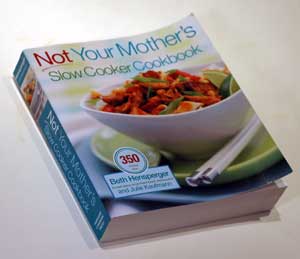 This cookbook starts
with breakfast and applies slow cooking techniques to oatmeal and
other grains making a hearty whole-grain nutritious breakfast
possible for even the most raucous morning households.
From there, the cookbook guides us through vegetable
preparations and many slow-cooked side dishes. An
entire chapter is devoted to preparing different grains in the slow
cooker. Suddenly, or rather slowly, a good
risotto is possible without any careful monitoring and titrating of
stock. Similarly, it seems that a slow cooker was
meant for making beans of all types. An
undervalued protein source and inexpensive in natural form, beans
adore the slow-and-low ways of this cooker.
Hensperger and Kaufmann round out their offering with
exhaustive instruction on slow cooking meat dishes of all
kinds. Not to be left out, two dessert chapters
are included. (The apple butter recipe is worth the price of the
book alone!). After perusing this cookbook,
you'll be ready to turn in your stovetop and convert to a totally
slow cooking
kitchen! This cookbook starts
with breakfast and applies slow cooking techniques to oatmeal and
other grains making a hearty whole-grain nutritious breakfast
possible for even the most raucous morning households.
From there, the cookbook guides us through vegetable
preparations and many slow-cooked side dishes. An
entire chapter is devoted to preparing different grains in the slow
cooker. Suddenly, or rather slowly, a good
risotto is possible without any careful monitoring and titrating of
stock. Similarly, it seems that a slow cooker was
meant for making beans of all types. An
undervalued protein source and inexpensive in natural form, beans
adore the slow-and-low ways of this cooker.
Hensperger and Kaufmann round out their offering with
exhaustive instruction on slow cooking meat dishes of all
kinds. Not to be left out, two dessert chapters
are included. (The apple butter recipe is worth the price of the
book alone!). After perusing this cookbook,
you'll be ready to turn in your stovetop and convert to a totally
slow cooking
kitchen! |
| RECIPE |
|
(Click here for a
printable version of the recipe in PDF
format).
White Bean and Kale
Tomato Soup
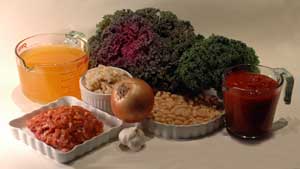 Warm your body and soul
with a generous portion of White Bean and Kale Tomato Soup that is a
nutritional powerhouse and high in flavor. Kale
is a sturdy green that fits well into soups. A
leafy, easily digestible relative to the cabbage, kale is considered
to be one of the most highly nutritious vegetables.
A powerful antioxidant with anti-inflammatory powers, kale is
very high in beta carotene, Vitamins K, A, C, and serves as a good
source of calcium. Wash kale well prior to
chopping. Kale will reduce to about one quarter
of its volume when cooked. This soup may be made
on the stovetop in your favorite soup pot, or in a slow cooker. Warm your body and soul
with a generous portion of White Bean and Kale Tomato Soup that is a
nutritional powerhouse and high in flavor. Kale
is a sturdy green that fits well into soups. A
leafy, easily digestible relative to the cabbage, kale is considered
to be one of the most highly nutritious vegetables.
A powerful antioxidant with anti-inflammatory powers, kale is
very high in beta carotene, Vitamins K, A, C, and serves as a good
source of calcium. Wash kale well prior to
chopping. Kale will reduce to about one quarter
of its volume when cooked. This soup may be made
on the stovetop in your favorite soup pot, or in a slow cooker.
(3) 14-oz. cans
vegetable stock
(1) 15-oz. can tomato puree
(1) 15-oz. can
White Cannellini Beans or Great Northern Beans, rinsed and
drained
1/2 cup rice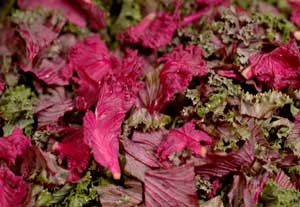
1 medium-sized yellow
onion, chopped
2 cloves garlic,
minced
2 teaspoons dried basil
Salt and freshly ground black
pepper to taste
1 pound kale, stems removed and leaves coarsely
chopped
1 pound Italian sausage, (optional) sautéed thoroughly
and drained of any fat
For
Serving:
Parmesan cheese
shavings
Olive oil for drizzling on top
Slow Cooker
Instructions: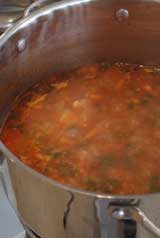
(1) Combine the broth,
tomato puree, beans, rice, onion, garlic, and basil in the slow
cooker, season with salt and pepper, and stir to blend.
Cover and cook on LOW for 5 to 7 hours.
(2) Stir in the kale and
sausage, and continue to cook on LOW until the kale is limp and
tender, another 20 to 30 minutes. When you add
the kale, it will fill the cooker at first; you can add it in
batches if you need to.
(3) Ladle the soup into
bowls and serve hot with Parmesan cheese and a drizzle of olive
oil.
Excerpted from Not
Your Mother's Slow Cooker Cookbook, by Beth
Hensperger & Julie Kaufmann. (c) 2005, used by permission from
The Harvard Common Press.
Stovetop
Instructions:
(1) Sauté sausage (if
using) until cooked thoroughly. Drain any excess
fat.
(2) Sauté chopped onion
in a small amount of olive oil until translucent.
Add minced garlic and cook for one minute.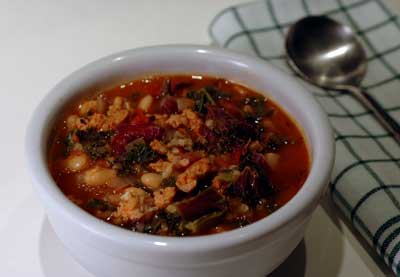
(3) Add vegetable stock,
tomato puree, beans, rice, dried basil, and salt and pepper to the
pot. Heat, then let simmer on the lowest heat
possible for 30-40 minutes, or until the rice is
tender.
(4) Add chopped kale, in
batches if necessary. Cook until wilted and
tender, about 10 minutes.
(5) Correct seasonings
and serve with the Parmesan cheese
shavings. | |